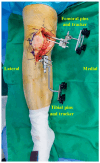Effectiveness of Periarticular Pin Tracker Placement Through a Single Main Incision in Robotic-Assisted Total Knee Arthroplasty: Technical Note and Short-Term Results
- PMID: 39459507
- PMCID: PMC11509473
- DOI: 10.3390/medicina60101720
Effectiveness of Periarticular Pin Tracker Placement Through a Single Main Incision in Robotic-Assisted Total Knee Arthroplasty: Technical Note and Short-Term Results
Abstract
Background and Objectives: Robotic-assisted total knee arthroplasty (TKA) is gaining popularity worldwide, leading to a potential increase in the number of pin tracker-related complications. This study determined the effectiveness of periarticular pin tracker placement in the distal femur and proximal tibia through a single main incision during robotic-assisted TKA over a minimum follow-up period of 6 months. Materials and Methods: A consecutive series of 149 TKAs was performed in 108 patients using the triathlon posterior-stabilized total knee prosthesis with a robotic-assisted system at our hospital from December 2023 to February 2024. Clinical outcomes and complications associated with pin tracker sites, including pin-site infection, neurovascular injury, hematoma, soft-tissue morbidity, and pin-site fracture, were assessed. Results: The mean Knee Society knee score improved from 42.5 preoperatively to 76.3 points at the final follow-up, whereas the mean Knee Society function score improved from 43.1 preoperatively to 78.1 points at the final follow-up (both p < 0.05). No patient experienced any minor or major complications related to the use of pin trackers in the distal femur and proximal tibia. Conclusions: This periarticular technique that uses pin trackers in the distal femur and proximal tibia through a single main incision could be a useful option for orthopedic surgeons while performing robotic-assisted TKA.
Keywords: complications; pin tracker; robotic-assisted system; total knee arthroplasty.
Conflict of interest statement
The authors declare no conflicts of interest.
Figures






Similar articles
-
Distal Femoral Pin Tracker Placement Prevents Pin Tract-induced Fracture in Robotic-Assisted Total Knee Arthroplasty.J Knee Surg. 2023 Mar;36(4):435-438. doi: 10.1055/s-0041-1735462. Epub 2021 Sep 10. J Knee Surg. 2023. PMID: 34507358
-
A Comparison of 90-Day Complication Rates Between Intra- and Extra-incisional Pin Sites in Robotic Total Knee Arthroplasty.J Arthroplasty. 2025 Jul;40(7S1):S96-S99. doi: 10.1016/j.arth.2025.01.030. Epub 2025 Jan 28. J Arthroplasty. 2025. PMID: 39884481
-
Distal Femoral Tracker Pin Placement Prevents Delayed Pin Tract-Induced Fracture in Robotic-Assisted Total Knee Arthroplasty: Results of Minimum 1-Year Follow-Up.J Knee Surg. 2023 Aug;36(10):1102-1104. doi: 10.1055/s-0042-1749605. Epub 2022 Jul 11. J Knee Surg. 2023. PMID: 35817054
-
Pin-Related Complications in Computer Navigated and Robotic-Assisted Knee Arthroplasty: A Systematic Review.J Arthroplasty. 2022 Nov;37(11):2291-2307.e2. doi: 10.1016/j.arth.2022.05.012. Epub 2022 May 7. J Arthroplasty. 2022. PMID: 35537611
-
Periprosthetic Fractures Through Tracking Pin Sites Following Computer Navigated and Robotic Total and Unicompartmental Knee Arthroplasty: A Systematic Review.JBJS Rev. 2021 Jan 26;9(1):e20.00091. doi: 10.2106/JBJS.RVW.20.00091. JBJS Rev. 2021. PMID: 33502139
References
-
- MAKO TKA Surgical Guide. [(accessed on 10 September 2024)]. Available online: https://www.tekno-surgical.com/uploads/mako-tka-surgical-technique.pdf.
-
- ROSA Knee User Manual & Surgical Technique V1.4. [(accessed on 10 September 2024)]. Available online: https://www.zimmerbiomet.com/content/dam/zb-corporate/en/education-resou....
-
- Real Intelligence CORI for Knee Arthroplasty. [(accessed on 10 September 2024)]. Available online: https://s3images.coroflot.com/user_files/individual_files/original_pdf_2....
MeSH terms
LinkOut - more resources
Full Text Sources
Medical

